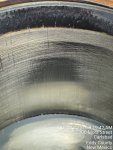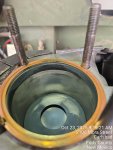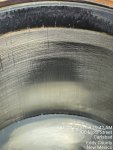Ok, oopsie on the rings, it happens. Fix that and see where you are. Although, from what you are describing, I think you are basically there.
Yes, I was concerned about carbon clogging the muffler from some of your earlier photos. The inside of the end of the muffler now looks very clean to me, so I would wait on that one. In fact, it seems to have less carbon in it now than before. With the muffler off the engine, you could try a small burst of compressed air from the end back toward the engine. Don't go wild. Mufflers aren't particularly robust. I'd be prepared for some amount of carbon, so I would not do that inside, and I would not point the end anywhere that you care about, just in case, especially anything electrical. While water and alkaline detergent can move a little bit of loose soot, not much actually dissolves carbon (soot) well, and most of the things that do ok with dissolving it or suspending are toxic or corrosive to the point that I wouldn't pour them into a muffler, hence, the recommendation to load up the engines and run it for a bit with the muffler on. From what you have described, you can get the unit pretty loaded, and I would run it at whatever level it can hang in there for
My experience with generators generally, but especially the smaller Yanmar based ones is that, yes, they do not like to have 100% of their load dropped on them at once. Larger versions with more moving mass and large windings have more tolerance for and ways of compensating for, sudden load changes, but I think a lot of it is just physics. The 831 doesn't have a great deal of rotational mass, it is a single cylinder, plus it is an inverter model, so I think that it is just intrinsically going to have a harder time with 0-100% changes in load.
All the best, 2PbFeet

















